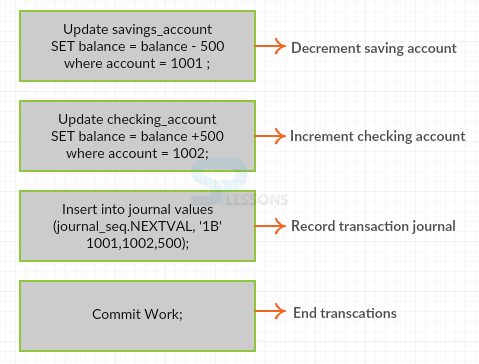 Description
Description
PLSQL Transaction is a coherent group of tasks that consists of more than single SQL statements. A transaction is a
nuclear unit and the impact of each SQL statement in a transaction can be either linked to the database or fixed from the database.
PLSQL Transaction starts by executing SQL statements. And, transaction closures after performing rolled back or commit either determinately by the ROLLBACK or COMMIT verifiable while a DDL statement is announced.
These transactions can be easily outlined by examining the database related to banking. At that point, the bank customer exchanges cash against an investment account to a financial record. The exchange can comprise of three isolated functions, such as:- reduction in savings account
- advancement in checking account
- Documents the translation in the transaction journal
 Description
Description
A transaction comprises of more than one explanation. In particular, a transaction comprises of
DML statements that together form a nuclear difference in the database, and the other comprises of DDL statements. The transaction consists of both start and end points.
The PLSQL Transaction starts when the main executable SQL statement is executed. SQL statements are the SQL explanations that sends signal to a database for occurrence, including the DDL and DML statements and the set of transaction explanations. At this point, when a transaction starts, database of Oracle relegates the accessible static information portion of a transaction to record the static sections of the updated transaction. And, a transaction ID will not be specified till the undo segment and transaction table space is provided, which happens during the main DML articulations. It contains an unique Transaction ID and produce the release section number, space, and arrangement number.
A transaction ends in any of the following condition
- When client troubleshoots Commit or Roll back statement beyond Save points conditions.
- Client executes a DDL statement, for example, Rename, Drop, Create or Alter.
- When client exits regularly from the Database tools and instrumental mechanism, creating the current transaction
- The confer conduct during the client detach is operation-subordinate and
- configurable.
- A user procedure ends unusually, bringing the transaction to a verifiable state. By using metadata, user can separate a part of the exchange table and then fix the fragment.
 Description
Description
The statements that can be performed efficiently are not similar to that of committed PLSQL Transaction. Processing effectively implies executing a single statement, and can be classified as follows:
In any case, until the transactions that contain the statements are committed, the exchange can be moved back, and the greater part of the statement progression can be fixed. An announcement as opposed to a transaction executes effectively.
Committing implies that a client has asked for the adjustments in the transaction to be done perpetual. An unambiguous request happens when the client issues a COMMIT explanation. A verifiable request happens after the end of an application or consummation of DDL statements. The changes are done by the SQL statements of a transaction that is noticeable to different clients when that exchange submits. Problems that are troubleshooted after the exchange submits must have conferred changes.
A transaction will be named based on Set Transaction, and the term statements can be assigned before beginning of the transaction. And, perform it with less demanding to screen long-range exchanges and determines uncertainty disseminated exchanges. And, transaction control is categorized into two types, they are:
- Parse
- Observed to be a substantial SQL development
- Keep running without mistakes in a nuclear unit. For instance, all lines of a multi row are changed.
- Statement-Level Rollback
- Resumable Space Allocation
 Description
Description
During the time of implementation, the statement will result few errors, and all impacts of the announcement are moved back. This impacts the rollback though that announcement has stopped running. This method is said to be announcements level rollback.
Errors found in the SQL articulation execution cause explanation-stage roll-backs. An instance of such errors hardly includes a copy value in a component. Individual SQL statements include deadlock. Errors discovered during the execution of SQL statements are likewise tend to appear during announcement level rollback. Errors will be found while parsing the SQL statement. For example, a punctuation mark.
 Description
Description
It gives a way to append, and continues the execution of database with extensive operations during the occurrence of space distribution disappointments. It empowers a controller to make restorative move rather than the Server Oracle database by giving back errors to the clients. And, after rectifying the error condition, the operation suspended will be continued.
An explanation keeps running in a presumable mode just when the user empowers resumbles semantics for the session utilizing the ALTER SESSION articulations.
It will be suspended when one of the following case happens,they are:
- Space quota exceeded condition
- Maximum extents reached condition
- Out of capacity condition
 Description
Description
Committing a transaction implies rolling out the improvements operated by the SQL statements inside the transaction. Information is conferred before the following actions taking place.
- It develops a fix data. This fix data consists of the old information values changed by the SQL articulations within the transaction.
- It creates a re-try section in the redo log support of the SGA. The re-try log record consists of the information piece and the roll-back piece. Before a PLSQL Transaction is committed, the progressions might flow into the disk. The progressions will be performed in the database of the SGA. And, these progressions might flow into the disk before a transaction is conferred.
- Inside the table transaction, the related fix table space records that the transaction has conferred, and then compare exceptional framework change with the number of allocated transaction and reported in the table.
- Oracle discharge locks clutched on tables and rows.
- The mechanism of log author composes re-try log sections in the SGA's re-try log cushions to the re-try log records. Likewise, it composes the transaction's SCN to the re-try log documents.
- Oracle notes whether the transaction is completed.
 Description
Description
Rolling back means fixing any progressions to information that are performed by SQL articulations inside of the uncommitted exchange. Oracle uses fix table spaces to store previous values. The re-try log contains records of changes. Oracle gives a chance to roll back the whole uncommitted transaction. On the other hand, it can also move the uncommitted exchange by back trailing to a marker called as save point. A wide range of roll backs make use of the same strategies.
- Statement-level roll back
- Rollback of a transaction due to client desire.
- Rollback to a save point.
- Rollback of incomplete transactions during reconstruction.
- Rollback of all dominant transactions separated.
- Rollback of a transaction due to abnormal actions consequences.
 Description
Description
Save points are comparably valuable in application programs. On the off chance, that a procedure contains few capacities, then to create a save point before each program starts. At that point, if a program is declined, it is very difficult to give back the information to its states before the program has started and re-run the function by constructing the parameters again or execute a recuperation activity.
- When a PLSQL Transaction is rolling back to a save point, the successive condition happens.
- Just the announcements Oracle will roll back after the save point.
- Oracle saves the predefined save point, however all save points that were build up after the predetermined one are lost.
- Oracle discharge every row lock and gained, so that save point however holds all information acquired before the save point.
 Key Points
Key Points
- PLSQL Transaction - Logical unit of work that contains SQL statements.
- Statement level roll back - Roll back is an operation of restoring the data into database.
- Resumable space allocation - Suspending and resuming of database operations.
- Commit - Making permanent changes in the database.
- Roll back - Roll back means returning to the previous state.
- Save points - Specify a point in a transaction and can later roll back it.




